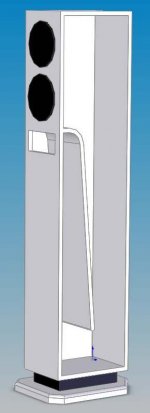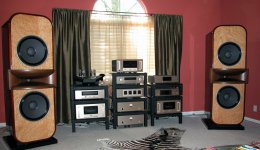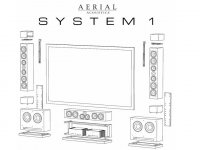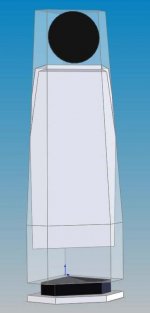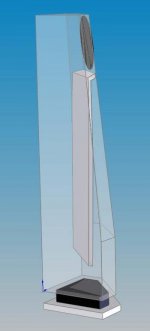Navin,
The corner is both a good and bad place depending on the room. It is good for bass reinforcement but as you say in some rooms the modes are such that it is not ideal. However, I as many others are not at liberty to place the sub in an ideal location. THis would require me to design an ideal listening space around speaker placement and as this is a multipurpose room I don't have that option.
One idea that I toyed with was to have the cabinet higher and have another woofer up higher in the cabinet with it's own TL. So you would have double TL's. The idea is to have the second driver at different spaces from the floor and ceiling boundries and then running both drivers with a seperate stereo amp so that you could adjust for the best sound. This might help deal with the modes for instance if one speaker is exciting too many of the wrong modes you could turn it down and pump up the volume of the other driver.
Hezz
The corner is both a good and bad place depending on the room. It is good for bass reinforcement but as you say in some rooms the modes are such that it is not ideal. However, I as many others are not at liberty to place the sub in an ideal location. THis would require me to design an ideal listening space around speaker placement and as this is a multipurpose room I don't have that option.
One idea that I toyed with was to have the cabinet higher and have another woofer up higher in the cabinet with it's own TL. So you would have double TL's. The idea is to have the second driver at different spaces from the floor and ceiling boundries and then running both drivers with a seperate stereo amp so that you could adjust for the best sound. This might help deal with the modes for instance if one speaker is exciting too many of the wrong modes you could turn it down and pump up the volume of the other driver.
Hezz
Greets!
From what I'm hearing you say, one of Rick Shultz's Alpha TLs loaded with an Adire DPL12 tuned to ~23-32Hz should 'fill the bill' depending on how much roll off you need below 30Hz and how long a pipe you'll tolerate.
The 23Hz TL essentially has an IB half space response to 20Hz in a straight taper ~6ft^3 before beginning its 12dB/octave roll off, whereas the 32Hz TL (same straight taper ~6ft^3) begins at ~28Hz, but it's almost 43" shorter and only 2dB lower at 10Hz so is the better 'bargain' IMO.
Lp (in) 101.887
So/SL (in^2) 95.339
Dp (lbs/ft^3) 0.918
Fb 32.000
Lp (in) 144.593
So/SL (in^2) 72.139
Dp (lbs/ft^3) 0.590
Fb 23.000
You can input these and the driver's specs into MJK's 'offset driver in an open ended TL' WS using the free V8 demo linked on his site to view or tweak them, though you can't save them except by pasting them into a WORD doc or similar.
GM
From what I'm hearing you say, one of Rick Shultz's Alpha TLs loaded with an Adire DPL12 tuned to ~23-32Hz should 'fill the bill' depending on how much roll off you need below 30Hz and how long a pipe you'll tolerate.
The 23Hz TL essentially has an IB half space response to 20Hz in a straight taper ~6ft^3 before beginning its 12dB/octave roll off, whereas the 32Hz TL (same straight taper ~6ft^3) begins at ~28Hz, but it's almost 43" shorter and only 2dB lower at 10Hz so is the better 'bargain' IMO.
Lp (in) 101.887
So/SL (in^2) 95.339
Dp (lbs/ft^3) 0.918
Fb 32.000
Lp (in) 144.593
So/SL (in^2) 72.139
Dp (lbs/ft^3) 0.590
Fb 23.000
You can input these and the driver's specs into MJK's 'offset driver in an open ended TL' WS using the free V8 demo linked on his site to view or tweak them, though you can't save them except by pasting them into a WORD doc or similar.
GM
Hezz said:Here is a model of what I think is the best performing of the TL types for a subwoofer. This was the only topology that has the 100 Hz suckout instead of the giant 100 Hz peak.

It could be made either a top firing or a bottom firing speaker with the right pedestal.
Hezz
This is about the same type of TL I used for my Focal 11" TL Sub:
An externally hosted image should be here but it was not working when we last tested it.
The only difference is I've got the driver and port on the side of the TL:
An externally hosted image should be here but it was not working when we last tested it.
I've build this Sub last winter using an Focal 11K5711 driver and am very satisfied with it.
http://www.t-linespeakers.org/design/classic.html
everything you need to know about the "classic" TL design...that cross section is far too small on the original design...but youve already ditched it.... well for thoes that hate links...here are seven things you need to know to get a good TL
sorry im late with my information...that is one of the many websites that tell great ways to make a TL...i myself am working on a TL design for fun for my truck using a single 8" woofer...see if i can get near the output of my Ava18 that is on its way
everything you need to know about the "classic" TL design...that cross section is far too small on the original design...but youve already ditched it.... well for thoes that hate links...here are seven things you need to know to get a good TL
1.) The line area should equal or exceed slighty the cone area of the driver used. Normally, it is difficult to make the line area exactly equal to the cone area, as the frame and mounting immediately force an area larger than the cone area. The area can be gradually tapered down to the actual area to save space, but it can remain the same as when it started, as long as it is not more than than about 20-25% more area. This means a very tight sizing for the woofer mount and the begining of the line.
2.) The line length should be 1/4 wavelength tuned to the resonant frequency of the chosen speaker IN THE BOX VOLUME CREATED BY THE TOTAL T-LINE CROSS SECTIONAL AREA TIMES LENGTH, and as if the box were a closed box. This is the hard part, as the line stuffing affects both the total apparent line length AND the total apparent box volume simultaneously. I will discuss this later.
3.) The line should be stuffed with an average of about 0.5 lbs to 0.7 lbs of acoustical stuffing material per cubic foot of line volume. The material chosen affects both the apparent speed of sound in the line AND the apparent increase in box volume. Fiberglass or polyfill can be used, but these are not the best. Acoustastuff and long hair wool are the prefered materials (the new Miraflex by Owens-Corning may be OK), these both have convoluted surfaces along the length of the fibers, which aid in the function of the material. Some argue that the density should be greater just behind the driver, and gradually taper off, while others argue that it should be uniform through out the line. I placed a little extra right behind the driver, and then made the rest of the line uniform.
4.) Contrary to popular belief, almost any driver can be used in a T-line, however, the driver resonant frequency IN THE APPARENT VOLUME OF THE T-LINE should be as low as you want the bass to extend, so if the driver in the apparent box volume of the T-Line has a resonant frequency of 60 Hz, and you wanted to get down to 40 Hz or 30 Hz, obviously, this one wouldn't be what you want. I wouldn't recommend trying to get super low, as the T-line will have a very shallow roll-off at the line tuning, and useful bass response will extend for an octave to an octave and a half below this point. My T-Line has a 40 Hz tuning, and what with room gain and all, it is -3 dB down at 20 hz.
5.) If the line stuffing and the tuning and the sizing and the spacing have all been done correctly, the T-line will be down approximately 6 dB at the tuning frequency in an anechoic envirionment. In most rooms, the bass lift due to walls and floor reinforcement will have the system near flat at this point, depending on the actual frequency. The effective slope of the roll off will be close to 6 dB/octave, and the low bass will not fall off a cliff like a classic vented box does.
6.) The walls of the line MUST be extremely rigid in order for the T-line to function as intended. Think in terms of making the walls TWICE as solid as a conventional enclosure, or better. Fortunately, the relatively small cross-sectional area, and traditional T-line construction techniques make this possible to achieve. My last enclosure used 3/4 ultra high density particle board laminated with 1/2 inch birch plywood.
7.) If the line is folded, place reflector plates in the corners. Pretend you are trying to smoothly direct a flow of liquid, make the fold or bend as smooth as you can. I placed a series of four reflector plates in my bends, two for each half of the line. If mounting the woofer facing forward, and having the exit port facing out to the side, these need reflectors also, especially the area behind the woofer.
sorry im late with my information...that is one of the many websites that tell great ways to make a TL...i myself am working on a TL design for fun for my truck using a single 8" woofer...see if i can get near the output of my Ava18 that is on its way

Hezz, what about weight?
One problem with TL subs is weight - both to lift it around when building, and then to move it into place. This is from someone who has been to the chiropractor from back injury when building TL mains!
First thing that comes to mind is Sonotube. They can be big, long, and light. You can also increase line length by placing them inside each other - a cylinder within a cylinder.
At least think of ways to make it lighter, the weight will be out of this world, or the walls will lack rigidity ... have you thought about curves? Vader's helmet, getting back to the original idea, has curves.
One problem with TL subs is weight - both to lift it around when building, and then to move it into place. This is from someone who has been to the chiropractor from back injury when building TL mains!
First thing that comes to mind is Sonotube. They can be big, long, and light. You can also increase line length by placing them inside each other - a cylinder within a cylinder.
At least think of ways to make it lighter, the weight will be out of this world, or the walls will lack rigidity ... have you thought about curves? Vader's helmet, getting back to the original idea, has curves.
Greets!
Hmm, I calc the larger of the two TLs I suggested at ~91lbs plus driver if made with 19mm BB ply, or ~12lbs < a sheet of 19mm MDF, so not excessively heavy. Just one more reason for never using MDF for a LF/midbass/lower mids BW cab IMO. Also, a square, rectangular, or tapered tube can easily be folded up to suit, which has the side benefit of increasing its rigidity, something you can't do with a cardboard tube.
WRT tube-in-tube, it works with two, but I found that any more 'stepping' didn't work well enough for me. As always though, YMMV.
GM
Hmm, I calc the larger of the two TLs I suggested at ~91lbs plus driver if made with 19mm BB ply, or ~12lbs < a sheet of 19mm MDF, so not excessively heavy. Just one more reason for never using MDF for a LF/midbass/lower mids BW cab IMO. Also, a square, rectangular, or tapered tube can easily be folded up to suit, which has the side benefit of increasing its rigidity, something you can't do with a cardboard tube.
WRT tube-in-tube, it works with two, but I found that any more 'stepping' didn't work well enough for me. As always though, YMMV.
GM
Guys,
Thanks for your posts. For me weight is almost a non issue because even though the cabinet will be heavy to work on it will rarely ever be moved. Also my previous cabinets though smaller were double wall. So a single wall of braced .75 inch MDF should not be that bad. I have a dolly to move the cabinet around.
I am fixing on a new design which I like even more. Here is a picture of the mockup. It can be either single or double driver as in this picture. I have a couple of 8 inch Dayton woofers around that I might experiment with. Maybe not. I like this tall and slender subwoofer because it makes it seem like it is not a subwoofer.
The sonotube is a good idea but I want the driver mounted verticaly so gravity doesn't make things more non linear.
Hezz
Thanks for your posts. For me weight is almost a non issue because even though the cabinet will be heavy to work on it will rarely ever be moved. Also my previous cabinets though smaller were double wall. So a single wall of braced .75 inch MDF should not be that bad. I have a dolly to move the cabinet around.
I am fixing on a new design which I like even more. Here is a picture of the mockup. It can be either single or double driver as in this picture. I have a couple of 8 inch Dayton woofers around that I might experiment with. Maybe not. I like this tall and slender subwoofer because it makes it seem like it is not a subwoofer.
The sonotube is a good idea but I want the driver mounted verticaly so gravity doesn't make things more non linear.
Hezz
Attachments
Human voice goes down to 80Hz. Orchestra bass at 40Hz maintains physical positioning in the sound stage on most full range stereo speakers.
I've always gotten better sound using full range stereo speakers with no shared subwoofer. Most HT receivers support a 5:0 mode that sums the subwoofer material onto the front stereo pair.
For HT, I found that the center channel is very important, and found that a 12" coaxial really centers the voice better than the more common MTM designs.
WMTMW, JBL 990 or TAD(e-Speakers attached), LineSources... full range speakers sound best to me.
Room corners might benefit from a tree and a bass trap.
I've always gotten better sound using full range stereo speakers with no shared subwoofer. Most HT receivers support a 5:0 mode that sums the subwoofer material onto the front stereo pair.
For HT, I found that the center channel is very important, and found that a 12" coaxial really centers the voice better than the more common MTM designs.
WMTMW, JBL 990 or TAD(e-Speakers attached), LineSources... full range speakers sound best to me.
Room corners might benefit from a tree and a bass trap.
Attachments
CBFryman said:everything you need to know about the "classic" TL design...
keep in mind that classic TL rules of thumb will maybe get you an optimal line 1 time out of 10... it can make a decent aperiodic enclosure with extension similar to sealed but with the advantages of "non-resonant" behavior.
dave
Linesource,
Nice setup. If I had more space and higher ceilings I would make the bass modules of the front speakers as subwoofers but the front mains speakers can be a maximum height of 36 inches to allow for the projection screen.
I have also found that the center channel has more bass range than most people believe. And as you say most deep male voices reach as low as 80 Hz. Therefore it is important the the center channel be a nearly fullrange speaker. THe large coaxial driver is a good idea and I have toyed with idea of a coaxial but not one that large. It seems that a 8 inch would be a better compromize since it is better in the midrange area than a 12 inch driver.
One thing that I think is important for the center channel is a simple crossover for better time domain response.
Hezz
Nice setup. If I had more space and higher ceilings I would make the bass modules of the front speakers as subwoofers but the front mains speakers can be a maximum height of 36 inches to allow for the projection screen.
I have also found that the center channel has more bass range than most people believe. And as you say most deep male voices reach as low as 80 Hz. Therefore it is important the the center channel be a nearly fullrange speaker. THe large coaxial driver is a good idea and I have toyed with idea of a coaxial but not one that large. It seems that a 8 inch would be a better compromize since it is better in the midrange area than a 12 inch driver.
One thing that I think is important for the center channel is a simple crossover for better time domain response.
Hezz
Hezz said:Nice setup.
While I'm not much for throwing the word around, I think that is a beautiful set-up.
Very nice indeed.
Cal
Hi Hezz,
The TAD speakers and equipment came from Andre's e-Speakers website. JBL has a similar configuration on their best home speakers. "Copy the Best" and leverage their years of R&D and testing.
Most good 3-ways can fill an 8' wide soundstage. Several companies are specializing in on-wall speakers for projection HDTV. (attachment) I build up-against-the-wall ribbon linesources, Heavy Metal for Sopranos 🙂 I want to protect all the ears in the family, and found that only 100+ db/watt speakers can create magic at 70 db SPLs.
For your projection set-up, could you fold your DIY T-line on the floor below the screen and create a __| shape with the T-line exiting near the floor just below the woofer, to merge the bass and get some floor gain? This might meet your 35" height.
For HT center channels, I think some beaming from a large diameter speaker is a good thing, as it helps to lock the voices in the center. I think this arrangement improves the left-center-right positioning effect, with very little up-down positioning compromise for under-the-screen center speakers.
I've built my own co-axial from a Lambda wide BW woofer and, at 1.2Khz LR4, a Seas Millennium tweeter with the front plate trimmed, and held just above the woofer phase plug with a tripod bracket mounting.
The TAD speakers and equipment came from Andre's e-Speakers website. JBL has a similar configuration on their best home speakers. "Copy the Best" and leverage their years of R&D and testing.
Most good 3-ways can fill an 8' wide soundstage. Several companies are specializing in on-wall speakers for projection HDTV. (attachment) I build up-against-the-wall ribbon linesources, Heavy Metal for Sopranos 🙂 I want to protect all the ears in the family, and found that only 100+ db/watt speakers can create magic at 70 db SPLs.
For your projection set-up, could you fold your DIY T-line on the floor below the screen and create a __| shape with the T-line exiting near the floor just below the woofer, to merge the bass and get some floor gain? This might meet your 35" height.
For HT center channels, I think some beaming from a large diameter speaker is a good thing, as it helps to lock the voices in the center. I think this arrangement improves the left-center-right positioning effect, with very little up-down positioning compromise for under-the-screen center speakers.
I've built my own co-axial from a Lambda wide BW woofer and, at 1.2Khz LR4, a Seas Millennium tweeter with the front plate trimmed, and held just above the woofer phase plug with a tripod bracket mounting.
Attachments
Kuiperik,
Great pictures. Are you up and running and how is the sound.
Linesource,
All good ideas. My problem is that the HT room is part of a multi purpose living space and I have to work around existing furniture objects.
I have come up with this new design that kind of blends the upright single bend TL and the darth vader theme cabinet into a tall upright corner cabinet. It will be a bit of a challange to built but I'm thinking of ways to do it. It will use a single DVC long xmax 12 inch driver driven with identical stereo amp channels.
Here is a solid model mockup. I have made the walls translucent so the internal partition can be seen.
Hezz
Great pictures. Are you up and running and how is the sound.
Linesource,
All good ideas. My problem is that the HT room is part of a multi purpose living space and I have to work around existing furniture objects.
I have come up with this new design that kind of blends the upright single bend TL and the darth vader theme cabinet into a tall upright corner cabinet. It will be a bit of a challange to built but I'm thinking of ways to do it. It will use a single DVC long xmax 12 inch driver driven with identical stereo amp channels.
Here is a solid model mockup. I have made the walls translucent so the internal partition can be seen.
Hezz
Attachments
where is the end/exit of the TL? below the speaker I presume? Nice angles... reduced standing waves? what frequencys are you using this speaker for? Cutting those panels will be fun!
To think of it though now, you really ought to put the sub on bottom and then have the exit on bottom also because this will get you a bit of boundry gain, plus it will be a more stable cabinet because the weight and vibrations will be at the bottom where it sits.
huge TL for a 12 btw
To think of it though now, you really ought to put the sub on bottom and then have the exit on bottom also because this will get you a bit of boundry gain, plus it will be a more stable cabinet because the weight and vibrations will be at the bottom where it sits.
huge TL for a 12 btw
Hezz said:Also the first chamber is roughly triangular in shape to reduce internal standing waves.
Hezz
Greets!
What standing waves (eigenmodes)? It's a sub, right? It's BW is too low for any to develop.
GM
LineSource said:I want to protect all the ears in the family, and found that only 100+ db/watt speakers can create magic at 70 db SPLs.
For HT center channels, I think some beaming from a large diameter speaker is a good thing, as it helps to lock the voices in the center. I think this arrangement improves the left-center-right positioning effect, with very little up-down positioning compromise for under-the-screen center speakers.
I've built my own co-axial from a Lambda wide BW woofer and, at 1.2Khz LR4, a Seas Millennium tweeter with the front plate trimmed, and held just above the woofer phase plug with a tripod bracket mounting.
Greets!
Agreed, and periodically 'preach' it, but apparently it mostly falls on 'deaf ears'. I prefer 15" drivers, or if smaller, then a conical horn to expand it to one.
GM
Hezz said:It seems that a 8 inch would be a better compromize since it is better in the midrange area than a 12 inch driver.
Hezz
Greets!
How so? I've found it to be quite the opposite.
GM
Granted,
It's big for a 12 inch subwoofer but it just fits where I need to put it. And by the way the exit port is missing as I forgot to put that in. But since it's only a concept mockup and I had already posted the pictures I will let them stand. THe exit of the TL will be just below the driver.
I really wanted a 15 inch but this was easier to get the size right with a 12 inch. My feeling is that with the DVC long xmax driver the bass output will be good for the medium size room that it is in.
I don't know how the voice coil is wound on a DVC subwoofer but I assume that the two channels are wound in an alternating pattern. This should space out the wires and make the voice coil move about twice as far for a given voltage input. Am I right on this. Anyone.
Hezz
It's big for a 12 inch subwoofer but it just fits where I need to put it. And by the way the exit port is missing as I forgot to put that in. But since it's only a concept mockup and I had already posted the pictures I will let them stand. THe exit of the TL will be just below the driver.
I really wanted a 15 inch but this was easier to get the size right with a 12 inch. My feeling is that with the DVC long xmax driver the bass output will be good for the medium size room that it is in.
I don't know how the voice coil is wound on a DVC subwoofer but I assume that the two channels are wound in an alternating pattern. This should space out the wires and make the voice coil move about twice as far for a given voltage input. Am I right on this. Anyone.
Hezz
Firstly Hezz this sub is getting very like what i am hoping to build.
similarities:
Corner Loaded Triangular right angled triangle.
12" DVC
tapered front baffle.
differences:
I am looking at putting sub driver at the bottom and inverting the TL. The inner brace/TL bend will not be vertical but at a slant that will taper the TL.
reasons:
1. the driver can be hidden behind the pot of a plant
2. more bounrdry reinforcement (thought I am not sure this is nessacarily good) this can be room dependant
3. weight of the sub is at the botom preventing the sub from tipping over though the tapered front baffle might solve that too.
The DVC subs I am hoping to use are from Audio Concpets. I had the opportunity to open one. It uses 2 magnets. There is an inner coil and outer coil. The DCR of both coils is the same but the Le is slightly different. In parallel the DCR of both is 3.1 ohms.
In my case I have 4 of these subs. 2 will be TL and 2 sealed (under sofa).
I am not sure who the subs will be connected to the sub amp. Either in parallel (stereo) or series (bridge amp to mono). I am using an old Carver M1.0t ( http://www.excelsis.com/1.0/entry.php?sectionid=16&entryid=39) for this. Any suggestions? The amp will be fed from the .1 output of the HT/AVR.
similarities:
Corner Loaded Triangular right angled triangle.
12" DVC
tapered front baffle.
differences:
I am looking at putting sub driver at the bottom and inverting the TL. The inner brace/TL bend will not be vertical but at a slant that will taper the TL.
reasons:
1. the driver can be hidden behind the pot of a plant
2. more bounrdry reinforcement (thought I am not sure this is nessacarily good) this can be room dependant
3. weight of the sub is at the botom preventing the sub from tipping over though the tapered front baffle might solve that too.
The DVC subs I am hoping to use are from Audio Concpets. I had the opportunity to open one. It uses 2 magnets. There is an inner coil and outer coil. The DCR of both coils is the same but the Le is slightly different. In parallel the DCR of both is 3.1 ohms.
In my case I have 4 of these subs. 2 will be TL and 2 sealed (under sofa).
I am not sure who the subs will be connected to the sub amp. Either in parallel (stereo) or series (bridge amp to mono). I am using an old Carver M1.0t ( http://www.excelsis.com/1.0/entry.php?sectionid=16&entryid=39) for this. Any suggestions? The amp will be fed from the .1 output of the HT/AVR.
- Status
- Not open for further replies.
- Home
- Loudspeakers
- Subwoofers
- Building the Darth Vader Corner Sub
